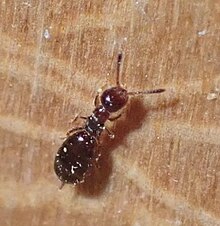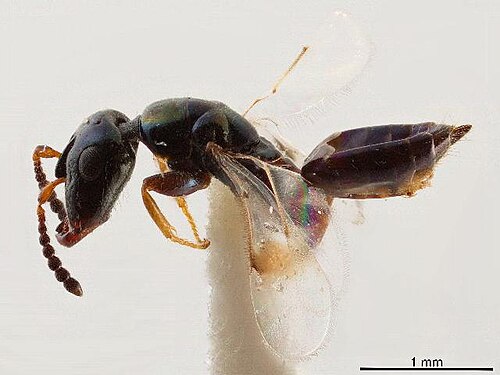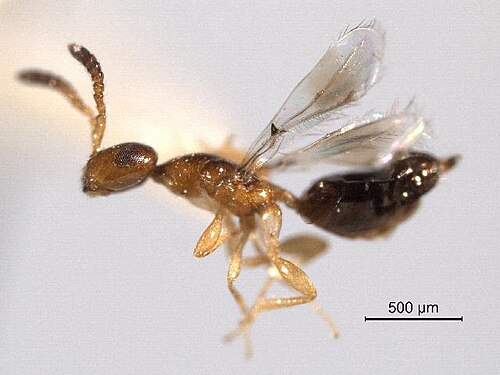| Cerocephalidae | |
|---|---|

| |
| Theocolax formiciformis female | |
| Scientific classification | |
| Domain: | Eukaryota |
| Kingdom: | Animalia |
| Phylum: | Arthropoda |
| Class: | Insecta |
| Order: | Hymenoptera |
| Superfamily: | Chalcidoidea |
| Family: | Cerocephalidae Gahan, 1946 |
| Genera | |
|
See text | |
Cerocephalidae is a small family of chalcid wasps, previously classified as subfamily Cerocephalinae, in the polyphyletic family Pteromalidae.[1] Most species are parasitoids of small wood-boring beetles.
Genera
[edit]- Acerocephala
- Cerocephala
- Choetospilisca
- Gahanisca
- Gnathophorisca
- Laesthiola
- Muesebeckisia
- Neocalosoter
- Neosciatheras
- Paracerocephala
- Paralaesthia
- Sciatherellus
- Theocolax
Fossil genera: Dominocephala, Pteropilosa, Tenuicornis.
Description
[edit]The antennae have up to 10 flagellomeres (up to 3 clavomeres). There is a prominence between the toruli (bases of the antennae). Eyes are not ventrally divergent, and mandibles have two or more teeth. All legs have five tarsomeres and the protibial spur is stout and curved. The metasoma has a syntergum.[1]
Gallery
[edit]-
Acerocephala atroviolacea
-
Cerocephala eccoptogastri
-
Neocalosoter scolytivora
-
Theocolax elegans
References
[edit]- ^ a b Roger A. Burks; Mircea-Dan Mitroiu; Lucian Fusu; et al. (20 December 2022). "From hell's heart I stab at thee! A determined approach towards a monophyletic Pteromalidae and reclassification of Chalcidoidea (Hymenoptera)". Journal of Hymenoptera Research. 94: 13–88. doi:10.3897/JHR.94.94263. ISSN 1070-9428. Wikidata Q115923766.




Well, that’s interesting to know that Psilotum nudum are known as whisk ferns. Psilotum nudum is the commoner species of the two. While the P. flaccidum is a rare species and is found in the tropical islands. Both the species are usually epiphytic in habit and grow upon tree ferns. These species may also be terrestrial and grow in humus or in the crevices of the rocks.
View the detailed Guide of Psilotum nudum: Detailed Study Of Psilotum Nudum (Whisk Fern), Classification, Anatomy, Reproduction